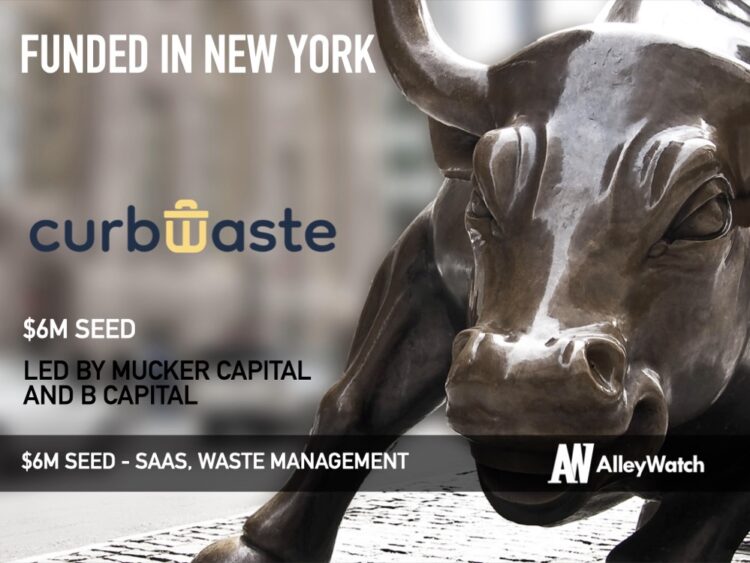When you think about the waste management industry, you may not think about technology. However, like other industries, the pandemic has fueled a digital revolution in the industry needing to compete with the realities of today’s landscape. Much of the attention has been focused on innovation on leveraging technology to address actual waste and collection like smart waste bins, recycling robots, sensors, and plasma gasification, ignoring the business of waste collection. CurbWaste is a SaaS platform that serves as an operating system for the waste management industry to optimize its operations. The cloud-based solution handles everything from inventory, orders, reporting, billing, and dispatch. Haulers and waste companies using the platform process several million transactions per month and CurbWaste’s subscription revenue has grown 60% month-over-month as the four-year-old company looks to cement its position within the $1T+ waste management industry.
AlleyWatch caught up with CurbWaste Founder and CEO Michael Marmo to learn more about the business, the company’s strategic plans, latest round of funding, and much, much more…
Who were your investors and how much did you raise?
We raised $6M with Mucker Capital and B Capital as a seed investment, bringing our total amount raised since our launch to $7.2M.
Tell us about the product or service that CurbWaste offers.
CurbWaste offers operational management software for haulers and transfer stations. CurbWaste and Weighworks provide cloud based solutions so haulers and transfer stations can use automated workflows and understand underlying data for their business.
 What inspired the start of CurbWaste?
What inspired the start of CurbWaste?
I started my career in a transfer station in Brooklyn, which is where I learned about the waste industry. From there I started my own hauling company, Curbside, which provided dumpster services for clients throughout the five boroughs. The initial iteration of CurbWaste was a proprietary software we used to enable our business to grow. After the COVID shutdown, we realized that digitization was going to accelerate throughout the waste industry so we decided to turn our proprietary software into a vertical SaaS product. And that’s how CurbWaste was born.
How is CurbWaste different?
We are software built by haulers for haulers. We understand the nuances of the industry and have built a system that takes those nuances and creates an automated workflow around them. We also understand that simplicity is key when training new staff so we focus on the user experience so it’s extremely easy and intuitive to use and learn.
What market does CurbWaste target and how big is it?
The waste industry is broken up into four parts. Generation, haul, disposal, and end use. We currently provide solutions for the collection companies (haulers) and the disposal facilities (transfer stations). This is a massive industry with over 15,000 private haulers across the United States and 5,000 transfer facilities. This doesn’t include municipalities and specialized waste.
What’s your business model?
We are a vertical SaaS provider and we offer our solution on a per user basis. Our model is simple, as you grow and become successful, we grow. We want to be what enables companies to take their operations to the next level and give them all the tools they need to be a large waste service provider.
How are you preparing for a potential economic slowdown?
Fortunately, waste never stops. It is one of the few privatized utilities that is crucial to our day-to-day lives. If waste collection were to stop, society would be immediately impacted. Coming from a cash flow business, we are extremely conscious of our spending much like our clients are. We feel a responsibility to make sure we invest what we need to in order to build a best-in-class product but also make sure we are viable for the long haul.
What was the funding process like?
We were fortunate to have investors who believed in us from the start. We definitely received a lot of no’s or “wait and see” but fortunately our current investors saw the opportunity and possibilities immediately. We have really enjoyed working with both Mucker Capital and B Capital thus far.
What are the biggest challenges that you faced while raising capital?
The most difficult challenge for me was learning and understanding what makes investors tick. I came from the waste industry and had never raised venture capital before. I had to learn what metrics were important, how to put together a concise and exciting story, and what types of investors were going to give us the best chance to succeed. Once we dialed in on those things, the rest fell into place.
What factors about your business led your investors to write the check?
First and foremost, we were founder market fit. We came with domain expertise and we have lived our customers’ problems. They also recognized that we would run through walls to make our customers successful. I also think vertical SaaS is an exciting space – and timing is everything.
What are the milestones you plan to achieve in the next six months?
Our main goals at this stage are to make our customers happy. We intend on doing that by hiring the best possible people we can to make sure our product provides the ultimate experience. We also intend on investing heavily in the product now that we have the resources to do so. Happy customers will get us to the next milestone.
What advice can you offer companies in New York that do not have a fresh injection of capital in the bank?
From the very beginning, we were cash flow conscious. We initially raised minimal capital and made sure that whatever capital we had, we used it effectively. You need to have a tangible understanding of the ROI for everything you do and not just throw money at problems. When you’re going out and preparing to raise, you need to have proven that customers are not only willing to buy your product but they are excited about its growth. We view all of our customers as partners in this journey and that pays dividends.
From the very beginning, we were cash flow conscious. We initially raised minimal capital and made sure that whatever capital we had, we used it effectively. You need to have a tangible understanding of the ROI for everything you do and not just throw money at problems. When you’re going out and preparing to raise, you need to have proven that customers are not only willing to buy your product but they are excited about its growth. We view all of our customers as partners in this journey and that pays dividends.
Where do you see the company going now over the near term?
We intend to grow our team in New York, Los Angeles, and Mumbai and build our logo portfolio with fast-growing waste companies. We are fortunate that we have capital to continue to invest in the customer experience and we are excited about reaching our revenue milestones and expanding our reach in the industry.
What’s your favorite outdoor dining restaurant in NYC?
Tough question! Jacksons in Long Island City and their outdoor brunch dining experience is excellent. I also enjoy basically any restaurant in Astoria.






